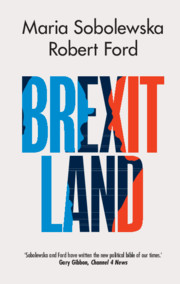Book contents
- Brexitland
- Reviews
- Brexitland
- Copyright page
- Contents
- Figures and tables
- Acknowledgements
- 1 Introduction: How Britain Became Brexitland
- Part I Demographic change and the emergence of new political divides over identity
- Part II Identity conflicts from New Labour to the Coalition
- Part III Brexitland
- 8 Brexitland Awakened: Identity Politics and the EU Referendum
- 9 Dancing to a Different Tune: Identity Politics and Political Change in Scotland, 2007–19
- 10 Brexitland after Brexit: The Electoral Fallout from the EU Referendum
- 11 Conclusion: The New Politics of Brexitland
- Bibliography
- Index
9 - Dancing to a Different Tune: Identity Politics and Political Change in Scotland, 2007–19
from Part III - Brexitland
Published online by Cambridge University Press: 21 September 2020
- Brexitland
- Reviews
- Brexitland
- Copyright page
- Contents
- Figures and tables
- Acknowledgements
- 1 Introduction: How Britain Became Brexitland
- Part I Demographic change and the emergence of new political divides over identity
- Part II Identity conflicts from New Labour to the Coalition
- Part III Brexitland
- 8 Brexitland Awakened: Identity Politics and the EU Referendum
- 9 Dancing to a Different Tune: Identity Politics and Political Change in Scotland, 2007–19
- 10 Brexitland after Brexit: The Electoral Fallout from the EU Referendum
- 11 Conclusion: The New Politics of Brexitland
- Bibliography
- Index
Summary
In this chapter we turn to the story of the Scottish independence referendum, to showcase how social and political context play a critical role in critically shaping identity conflicts. Similar demographic and value divides were present in the Scottish Independence and EU referendums, and in both contexts a nationalist party had surged to prominence in part by mobilising these divisions and promoting constitutional change. Both Independence and Brexit won their strongest early support from identity conservative voters wishing to ‘take back control’, and in both cases the electoral success of nationalist parties advocating withdrawal from a larger union was a key factor leading to the holding of an exit referendum. Yet despite these parallels, the politics of the two referendums has been very different. Different patterns of identity attachment explain the divergent patterns of conflict and ultimately their outcomes – Scottish attachments to an overarching British identity are much stronger than English or British attachments to a European identity, while negative views of England and Westminster as out-groups are much weaker in Scotland than negative views of the EU and Brussels as out-groups in England. We also reflect on what lessons the political aftermath of divisive referendum campaigns Scotland offers.
Keywords
- Type
- Chapter
- Information
- BrexitlandIdentity, Diversity and the Reshaping of British Politics, pp. 250 - 283Publisher: Cambridge University PressPrint publication year: 2020

